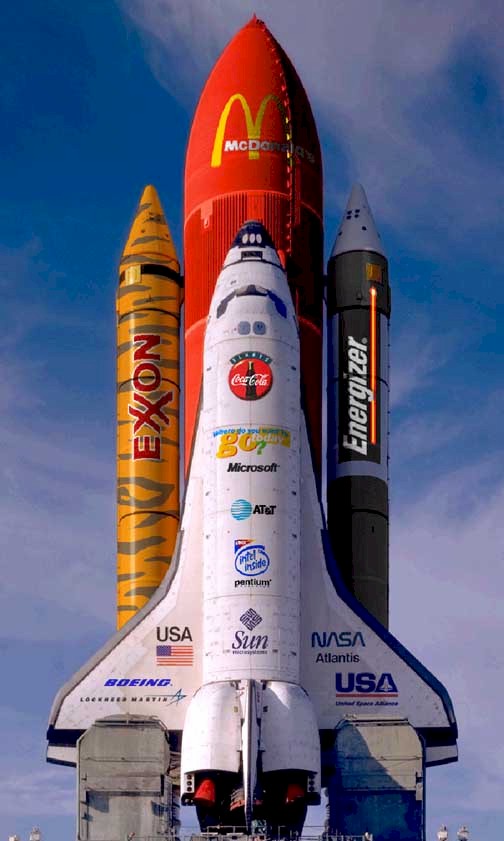Should We Advertise for Christ?
 Florida Space Coast- Apr 1, 2010:
Florida Space Coast- Apr 1, 2010:
Every day we are slammed with requests to buy this or subscribe to that. Billboards appeal to our sexual desires, our food choices, changing our hair color, loosing weight, or appealing to our compassion. While driving to work, radio commercials share the ride with true content only a small percentage of our travel time. Television is no better. Commercials have higher volume than the programs we tuned in to watch. We are shouted at, emailed to, seduced and frightened into giving up our attention and often our values to get the “deal”.
This constant barrage of requests is directed at all age groups. Peer pressure to own THAT car or be seen wearing THOSE shoes is real. The requests are overt. They are on cereal boxes, sides of buses, on park benches and in Internet searches. Children are manipulated to ask for the popular toy or movie relics. Sport teams hawk shirts, hats, and even underwear. It takes significant effort to avoid advertisements on a minute to minute basis.
How can we put God first in this cacophony of worldly requests? With so many asking for our attention, reflecting on the importance of God in our lives seems reserved to the time we spend in houses of worship. One answer of putting God more into our lives is to reserve time each morning and evening to thank Him for what He does for us each day. The moment we first wake and the seconds before we sleep are wonderful commercial free times to have conversations with God.
So what has this posting have to do with Cross on the Moon? The answer is in the belief that corporate advertisements will not stop. Sponsorships for big projects will always be needed. Building private spaceships to reach the moon and perform work there will require investors. Advertising helps pay for the mission when tax-funded programs fade away.
Private corporations will place a mobile machine on the moon before the end of 2014. One task the small rover has will be to travel the length of 5 football fields or more. The rover has to broadcast to the earth in high definition television. It will be a global event, complete with advertising campaigns before, during, and after the machine crawls or hops its way across the lunar surface. Advertising will help offset the mission costs. The unmanned event on the moon will be hard for the public to ignore. Many will say it will be historic because it will be a moon landing accomplished by private enterprise, not by a government. As always, financial support of risky projects is difficult but even more so when done privately. Still, sponsors of the successful moon mission have an incredible opportunity for a global audience.
The total cost for the mission will be over $100 million. We know this from past lunar missions. There are a lot of technical risks but over 30 teams have entered the competition. Google along with the X Prize Foundation, a non-profit charity has offered a $30 million incentive to the first privately funded team to accomplish their mission. They are offering a prize as a catalyst, in the same spirit as sponsoring the crossing of the Atlantic by powered flight that Charles Lindberg won. When he landed in Paris, few people imagined the business that air travel is today. Many entrepreneurs believe the moon can sustain future industries. For the companies that take a risk, one reward is advertising their logos while the rover has power to broadcast.
In the Google X Prize requirements, the lunar rover must look at itself at one point in the mission and broadcast by television the Google Lunar X logo applied to its chassis. Other sponsor logos can surround Google’s logo but center attention belongs to Google.
Cross on the Moon believes a simple cross decal should be on the chassis too. It will unfortunately be nestled with logos of industry giants and brands that want your patronage along with a host of others trying to get your attention. But the Christian cross will be a statement to the billions watching from earth that although mankind applies science and technologies to reach for the stars, we take our passion for Christ with us.
Your Christian decal will not be the largest or the flashiest design on the lunar rover. It won’t have the best placement in the sponsor area. But the symbol of the cross represents eternal life to billions on earth. Without the symbol of faith, we again become overwhelmed by worldly messages and forget who made all things possible.
Let’s not be awed by graphics of corporate sponsors the days when the rover broadcasts from the moon. Instead, we can quietly seek out the plain cross symbol and recognize it for what it means on earth and in your hearts. Understand that it is through faith that all great works of man are done. The men and women who design the rockets, assemble the rover, and guide it on its mission have relationships with God. They attend church, pray regularly, and make moral decisions and raise families based on the person and works of Jesus Christ. The machine that goes to the moon and the rover that travels on its surface will be a brief extension of us. Faith is an integral part of our being human.
Any machine man places on the moon will eventually loose power and stop broadcasting. It will be forgotten in time. No one will see the machine from earth, even with a powerful telescope. However, the rover that goes to the moon will far outlast any man-made artifact on earth, even the Egyptian pyramids. Therefore, we think it is fitting that such a persistent object, destined to be viewed by billions, be graced with our connection to Jesus.
Who Owns the Moon?
 Legal experts say the moon can not be claimed by countries and citizens of those countries under the 1967 Outer Space Treaty which has been ratified by 100 UN countries, including the United States. “The moon is just another continent across a different kind of sea”said Peter Kokh, president of the nonprofit Moon Society. In a National Geographic quote from National Geographic on-line:
Legal experts say the moon can not be claimed by countries and citizens of those countries under the 1967 Outer Space Treaty which has been ratified by 100 UN countries, including the United States. “The moon is just another continent across a different kind of sea”said Peter Kokh, president of the nonprofit Moon Society. In a National Geographic quote from National Geographic on-line:
The process of colonizing the moon’s challenging landscape will change the needs and wants of the society that settles there-just as desires of English colonists changed when they got to the new world.
So if we take these two thoughts: 1) the moon is just another continent across a different kind of sea, and 2) when humankind settles an uninhabited continent, it will adapt based on the desires of its colonists, then having faith-based missions to the moon today are a means to lay ethics for the future.
On July 20, 1969, astronauts stepped onto the moon and planted an American flag—not to claim the moon but simply to commemorate the U.S. role in the first moon landing. Planting a symbol of sovereignty on the moon does not entitle a country to lunar ground. In this spirit Christians intend to place a cross on the moon; to lift up their belief in God, the creator of the universe. The act is not a form of manifest destiny.
Separation of Church and Space?
It is naive to believe governments and industry can separate church from space. Freedom to worship should be fundamental and granted to all. Colonizing the moon and beyond will take extreme effort and sacrifices from individuals. Respect, not ignorance of faith should prevail. Faith is important as we celebrate, rejoice, sing, and yes, grieve. Instead of seeking exclusivity of one faith on the moon, the future of colonizing it and beyond requires recognizing that the moon is open to all. Perhaps a council of theologians to represent people of all faiths should be formed.
Acts of Worship in Space
Cross on the Moon understands the controversy to worship on the moon. They may be the first to place a symbol of faith there but there is no expectation to be exclusive in this regard. For traveling through space, humankind requires different types of ships than ones that float on water or lift themselves with air. Then as now people will carry their faith to distant shores for future travelers and residents. These are the times to prepare.
Joy to the World… to the moon and beyond!
God Bless Everyone.
Can We Buy a Stairway to Heaven?
September 12, 2009 by Clarknator
Filed under Faith
Pittsburgh Pa – Sep 2009
 Most of us know the English rock band Led Zeppelin’s 1971 song “Stairway to Heaven”. It portrays a woman trying to buy her way to Heaven. Some might say that placing a cross on the moon falls into a category of similar, self-serving needs. This post counters that position on several fronts.
Most of us know the English rock band Led Zeppelin’s 1971 song “Stairway to Heaven”. It portrays a woman trying to buy her way to Heaven. Some might say that placing a cross on the moon falls into a category of similar, self-serving needs. This post counters that position on several fronts.
‘There’s a lady is sure [sic], all that glitters is gold, and she’s buying a stairway to heaven’.
Robert Plant’s own explanation of the lyrics was that it “was some cynical aside about a woman getting everything she wanted all the time without giving back any thought or consideration.”
Cross on the Moon is not about buying a stairway to Heaven. Buying passage to the moon is not going to Heaven but entering a harsh, airless place that only 12 men have set space-suited feet upon. Forget the NASA conspiracy theories. Men really went there. It is certainly not “Heaven”.
Perhaps in a metaphorical way we are trying to buy forgiveness. Christians know that price was already paid. The Gospel can help us distinguish going to Heaven from buying our way there. Simply: 1) You have to be perfect to go to Heaven. 2) No one is perfect. 3) That’s why you need a Savior.
To be clear, we are asking for public support to buy a one-way ticket to the farthest accessible place from where Jesus was crucified. A machine will place it for us and machines will be our eyes to the event. The mission will not be a trivial accomplishment and only historic in a reverence sense when God’s people can say they were united in placing it there.
Diving a bit deeper into our motivation: It takes strong character to make the right decisions when, as a people and as individuals, we face hard challenges. Much like the Labrador that loves to fetch the stick or salmon that return to spawn, we are wired to explore. We have a wonderful ability to use logic to advance our collective knowledge. Faith and science are not at odds. In fact, they balance each other. When we don’t have a base for making ethical and moral decisions, horrible things happen. Dr. Bruce Bickel, former pastor and published motivational speaker, said “Character precedes conduct; who we are determines what we will do.”
Cross on the Moon Foundation acts in reverence to put a symbol of Christian faith, that is, a tangible thing to acknowledge that God makes all human achievement possible. Remembering the cross should precede mankind’s advances into the Universe. Our mission doesn’t center on a specific religion. Charities like caring for the homeless, curing the sick, comforting the aged are hugely important. God makes those acts possible because of the spiritual gifts He gives us. But consider that God also gives us the gift to explore. Cross on the Moon is about praising God as we go forward. In a recent post onwww.rfe/rl.org: Faith and Reason in The Year of Astronomy-Jan 17 2009 , Guy Castelgandolfo, a Jesuit trained at MIT, said: “Religion tells me about Who created the Universe. Science tells me how He did it.”
The Cross on the Moon Foundation believes it is better to receive a million $1 contributions than one $1,000,000 donation. The real mission is about honoring God. All things originated from Him, including the ability to use scientific reasoning. It should be our hearts desire to give this glory to Him.
Size really doesn’t matter here. A small cross on the Moon means nothing to God. Our web site can’t show how large the Universe is. But as small as we are, God cares for me and for you and all creatures, no matter how much we don’t get it right. While not politically acceptable in an age of “self”, our purpose is to please Him. What “pleases” God is when we gather to honor Him. That’s what Cross on the Moon is about. The first Commandment is honoring God with all your heart, mind, and spirit. This is found in the Old Testament and is the first of the two Commandments Jesus states in the New Testament. All 10 Commandments appear in Christianity, Islam, and the Jewish faiths. These are essential to society and form the foundation of our moral compasses. No one can buy a stairway to Heaven, but God has equipped us to praise Him wherever we go.
Faith And Reason In The ‘Year Of Astronomy’
 Madrasahs, like this one in Bukhara, were key to developments in mathematics, astronomy, and the arts.
Madrasahs, like this one in Bukhara, were key to developments in mathematics, astronomy, and the arts.
January 17, 2009
by Jeffrey Donovan
Heaven may be religion’s business, but the heavens — the planets and stars — are astronomy’s.
Well, not quite.
Mankind’s quest for God has always pointed to the heavens. It’s no accident, then, that the path of faith led Muslim astronomers — and, later, Christian Europeans — to discover scientific truths behind the planets and the stars.
As the world marks the International Year of Astronomy, the historic links between religion and science, faith and reason, are worth nothing, says Guy Consolmagno, an acclaimed American astronomer. Of course, Consolmagno, after whom an asteroid is named, is also a Jesuit who does his research at the Vatican Observatory in the papal summer palace at Castelgandolfo, south of Rome.
“John starts the gospel, ‘In the beginning was the Word.’ Now, the word ‘word’ is actually the Greek ‘logos’ which is where we get the word ‘logic’ from,” Consolmagno tells RFE/RL. “And to the Greek philosophers of that time, that word carried such a weight because it meant reason, it meant logic. And so the Gospel is saying, at the beginning was logic, was reason, were the laws of the universe. These were with God — these were God.”
As God was worth knowing, so began the quest for scientific truth, which from the earliest days fixed its gaze on the stars.
Early Successes
Ancient Persia, India, and Greece made the world’s first astronomical breakthroughs. Ptolemy of Roman Egypt, who wrote in Greek, believed Earth was the center of the universe around which the sun, planets and stars revolved. His theory stood until the 16th century when Copernicus, a Pole, defied Roman Catholic teaching and put the sun at the center of the solar system amid a much vaster universe.
His theory was confirmed by Italian Galileo Galilei, called the “father of observational astronomy” because of improvements he made to the telescope. The Year of Astronomy, kicked off by the United Nations in Paris on January 15-16, is dedicated to the 400th anniversary of Galileo’s first discoveries in 1609, which led to his imprisonment by the Vatican for heresy.
After Galileo, the Age of Reason and science would sweep Europe, leaving the rest of the world behind. But between Ptolemy and Galileo, a gap of some 1,500 years, was the “Golden Age” of Islamic astronomy, which first transformed the art of sky gazing into a pure science of the stars.
There is also growing evidence that Islamic astronomers, whose Arabic translations were often the only surviving texts of ancient Greek works including Ptolemy’s, provided fundamental impetus to the European Renaissance and the scientific explosion that followed it.
The Koran itself invites believers to find guidance in the movement of the stars. It also insists, “the Universe is ruled by a single set of laws” — which, like the Gospel of John, seems to put logic and reason behind creation.
The first Muslim astronomers studied the heavens to develop a new Islamic calendar, based on the need for months to begin when the crescent moon first appears. Called to pray five times a day, they were also compelled to find a mathematical way to fix Mecca’s direction from any location.
From Baghdad to Samarkand, from Al-Andalus (southern Spain) to Istanbul, the list of great Islamic astronomers runs long and rich.
Among the most celebrated are Albetenius, who around the year 900 determined the solar year as being 365 days, five hours, 46 minutes and 24 seconds. Other greats include Ulugh Beg, the Turkic astronomer born in Persia who made key advances in trigonometry and star cataloguing, and in the 1400s established a school on Registan Square in Samarkand, now in Uzbekistan.
Seeking Consistency
Lebanese-born George Saliba is a historian of Islamic science at Columbia University in New York. In his latest book, “Islamic Science and the Making of the European Renaissance,” Saliba traces the links between the Islamic “Golden Age” of astronomy and the Age of Reason in Europe. In particular, he cites new evidence of Arabic science impacting the work of Copernicus.
Saliba says Muslims made astronomy into a science by focusing on empirical research and developing the mathematics to support it. That proved a huge advance, he says, on the ancient world, which saw the stars in a mythological sense — as symbols of gods and deities.
“What Islam has done, what Islamic civilization has produced, is to say that astronomy is just like any other scientific discipline: It has to be consistent in explaining the physical phenomena around us with a mathematical language,” Saliba tells RFE/RL. “Of crucial importance is the emphasis on the mathematical language, that the language should be consistent with the physics we are describing. This inner consistency of science is the single most important contribution that Islamic astronomy has made.”
But where have all the great Islamic astronomers and scientists gone?
Some historians, such as Lebanon’s Amin Maalouf, blame the decline of Islamic science since the 16th century on a lack of political freedom in the Muslim world relative to that enjoyed in Europe, even under the monarchies.
Saliba, however, says the whole world fell behind Europe, scientifically.
“The rest of the world began to look comparatively as if it went into decline,” he says. “This does not only touch Islamic civilization. It touches the Indian, it touches the Chinese, and it touches actually the whole non-European world. So trying to answer this question by finding something wrong in the Koran, or something wrong in Islam misses the point, because it is not particular to Islam. It’s a universal phenomenon that Europe began to take off and the rest of the world was left behind.”
With Galileo the poster child of the Year of Astronomy, some point to his persecution by the Catholic Church as proof that religion and science can’t co-exist. It wasn’t until 1992 that Pope John Paul II apologized and rehabilitated Galileo.
But Consolmagno says many great scientific discoveries since Galileo were by Catholic clerics. Like the Big Bang theory, which George Lemaitre, a Belgian priest, first proposed in reaction to Albert Einstein’s theory of relativity.
For the American Jesuit, trained at the Massachusetts Institute of Technology, the quest for truth is at the heart of faith and science. “Religion tells me who made the universe,” Consolmagno says. “Science tells me how he did it.”
Article Source- Radio Free Europe
1 Corinthians 15: 40-41
 “There are also celestial bodies, and bodies terrestrial: but the glory of the celestial is one, and the glory of the terrestrial is another.
“There are also celestial bodies, and bodies terrestrial: but the glory of the celestial is one, and the glory of the terrestrial is another.
“ There is one glory of the sun, and another glory of the moon, and another glory of the stars: for one star differeth from another star in glory.”
(King James Version)
Jeremiah 31: 35-37
 “Thus saith the Lord, which giveth the sun for a light by day, and the cordinances of the moon and of the stars for a light by night, which divideth the sea when the waves thereof roar; The Lord of hosts is his name:
“Thus saith the Lord, which giveth the sun for a light by day, and the cordinances of the moon and of the stars for a light by night, which divideth the sea when the waves thereof roar; The Lord of hosts is his name:
“If those aordinances depart from before me, saith the Lord, then the seed of Israel also shall cease from being a nation before me for ever.
“Thus saith the Lord; If heaven above can be measured, and the foundations of the earth searched out beneath, I will also cast off all the seed of Israel for all that they have done, saith the Lord.
(King James Version)
“God’s Message, from the God who lights up the day with sun and brightens the night with moon and stars,
“Who whips the ocean into a billowy froth, whose name is God-of-the-Angel-Armies:
“If this ordered cosmos ever fell to pieces, fell into chaos before me” —God’s Decree—
“Then and only then might Israel fall apart and disappear as a nation before me.”
(The Message)
PSALM 147:4
 “He telleth the number of the stars; he calleth them all by their names.”
“He telleth the number of the stars; he calleth them all by their names.”
(King James Version)
Genesis 1: 16
 “And God made two great lights; the greater light to rule the day, and the lesser light to rule the night: he made the stars also.
“And God made two great lights; the greater light to rule the day, and the lesser light to rule the night: he made the stars also.
“And God set them in the afirmament of the heaven to give light upon the earth,
“And to rule over the aday and over the night, and to divide the light from the darkness: and God saw that it was good. ”
(King James Version)
“God made two big lights, the larger to take charge of Day,
“The smaller to be in charge of Night; and he made the stars.
“God placed them in the heavenly sky to light up Earth
“And oversee Day and Night, to separate light and dark.”
(The Message)
Psalm 19:1-2
 “The heavens declare the glory of God; and the firmament sheweth his handywork.
“The heavens declare the glory of God; and the firmament sheweth his handywork.
“Day unto day uttereth speech, and night unto night sheweth knowledge.”
(King James Version)
“The heavens declare the glory of God; And the firmament shows His handiwork.
“Day unto day utters speech, And night unto night reveals knowledge.”
(The Message)
Psalm 89:37
 “His seed shall endure for ever, and his throne as the sun before me.
“His seed shall endure for ever, and his throne as the sun before me.
“It shall be established forever like the moon, Even like the faithful witness in the sky.” Selah
(King James Version)

